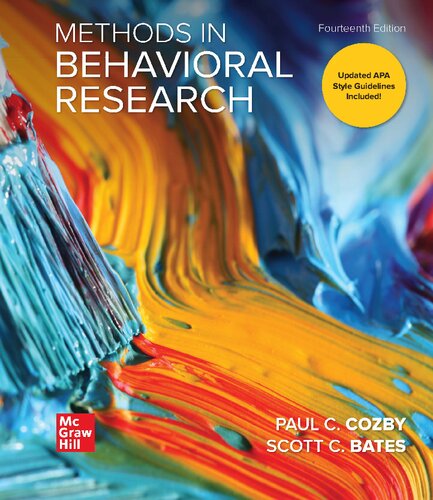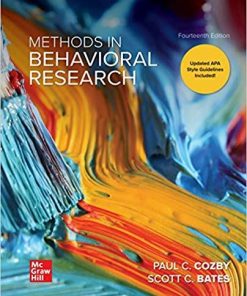(Ebook PDF) Loose Leaf for Methods in Behavioral Research 14th Edition by Paul Cozby 1260546942 9781260546941 full chapters
$50.00 Original price was: $50.00.$25.00Current price is: $25.00.
Loose Leaf for Methods in Behavioral Research 14th Edition by Paul C. Cozby – Ebook PDF Instant Download/DeliveryISBN: 1260546942, 9781260546941
Full dowload Loose Leaf for Methods in Behavioral Research 14th edition after payment.

Product details:
ISBN-10 : 1260546942
ISBN-13 : 9781260546941
Author: Paul C. Cozby
Methods in Behavioral Research
Loose Leaf for Methods in Behavioral Research 14th Table of contents:
Chapter 1 Scientific Understanding of Behavior
Importance of Research Methods
Ways of Knowing
Goals of Behavioral Science
Basic and Applied Research
Study Terms
Review Questions
Activities
Answers
Chapter 2 Where to Start
Research Questions, Hypotheses, and Predictions
Sources of Ideas
Types of Research Reports
Exploring Past Research
Study Terms
Review Questions
Answers
Chapter 3 Ethics in Behavioral Research
Milgram’s Obedience Experiment
Historical Context of Current Ethical Standards
APA Ethics Code
Assessment of Risks and Benefits
Informed Consent
The Importance of Debriefing
Institutional Review Boards
Research with Nonhuman Animal Subjects
Being an Ethical Researcher: The Issue of Misrepresentation
Conclusion: Risks and Benefits Revisited
Study Terms
Review Questions
Activities
Answers
Chapter 4 Fundamental Research Issues
Validity: An Introduction
Variables
Operational Definitions of Variables
Relationships Between Variables
Nonexperimental Versus Experimental Methods
Experimental Methods: Additional Considerations
Evaluating Research: Summary of the Three Validities
Study Terms
Review Questions
Activities
Answers
Chapter 5 Measurement Concepts
Reliability of Measures
Construct Validity of Measures
Reactivity of Measures
Variables and Measurement Scales
Study Terms
Review Questions
Activities
Answers
Chapter 6 Observational Methods
Quantitative and Qualitative Approaches
Naturalistic Observation
Systematic Observation
Case Studies
Archival Research
Study Terms
Review Questions
Activities
Answers
Chapter 7 Asking People about Themselves: Survey Research
Why Conduct Surveys?
Constructing Questions to Ask
Responses to Questions
Finalizing the Survey Instrument
Administering Surveys
Survey Designs to Study Changes Over Time
Sampling From a Population
Sampling Techniques
Evaluating Samples
Reasons for Using Convenience Samples
Study Terms
Review Questions
Activities
Answers
Chapter 8 Experimental Design
Confounding and Internal Validity
Basic Experiments
Assigning Participants to Experimental Conditions
Study Terms
Review Questions
Activities
Answers
Chapter 9 Conducting Experiments
Selecting Research Participants
Manipulating the Independent Variable
Measuring the Dependent Variable
Additional Controls
Final Planning Considerations
Analyzing and Interpreting Results
Communicating Research to Others
Study Terms
Review Questions
Activities
Answers
Chapter 10 Complex Experimental Designs
Increasing the Number of Levels of an Independent Variable
Increasing the Number of Independent Variables: Factorial Designs
Outcomes of a 2 × 2 Factorial Design
Assignment Procedures and Factorial Designs
Increasing the Number of Levels of an Independent Variable
Factorial Designs with Three or More Independent Variables
Study Terms
Review Questions
Activitie
Answers
Chapter 11 Single-Case, Quasi-Experimental, and Developmental Research
Single-Case Experimental Designs
Quasi-Experimental Designs
Developmental Research Designs
Study Terms
Review Questions
Activities
Chapter 12 Understanding Research Results: Description and Correlation
Scales of Measurement: A Review
Describing Results
Frequency Distributions
Descriptive Statistics
Graphing Relationships
Correlation Coefficients: Describing the Strength of Relationships
Effect Size
Regression Equations
Multiple Correlation/Regression
The Third-Variable Problem
Structural Equation Modeling
Study Terms
Review Questions
Activities
Answers
Chapter 13 Understanding Research Results: Statistical Inference
Samples and Populations
Inferential Statistics
Null and Research Hypotheses
Probability and Sampling Distributions
Group Differences: The t and F Tests
Type I and Type II Errors
Choosing a Significance Level
Interpreting Nonsignificant Results
Choosing a Sample Size: Power Analysis
The Importance of Replications
Significance of a Pearson r Correlation Coefficient
Computer Analysis of Data
Selecting the Appropriate Statistical Test
Study Terms
Review Questions
Activities
Answers
Chapter 14 Generalization
Generalizing to Other Populations
Generalizing Across Methods
Supporting Good External Validity
The Importance of Replications
Evaluating Generalizations via Literature Reviews and Meta-analyses
Using Research to Improve Lives
Study Terms
Review Questions
Activities
People also search for Loose Leaf for Methods in Behavioral Research 14th:
what does loose leaf mean for textbooks
behavior research methods impact factor
behavioral research methods journal
loose-leaf version for psychology
loose-leaf binding
You may also like…
Business & Economics - Accounting
Loose Leaf for Cost Management: A Strategic Emphasis 8th Edition
Uncategorized
Science (General) - Scientific and popular: Journalism
Methods in Behavioral Research 15th Edition by Paul Cozby 1260883077 9781260883077
Business & Economics - Personal Finance
Chemistry - Organic Chemistry
Loose Leaf for Organic Chemistry with Biological Topics 6th edition Edition Smith
Business & Economics - Economics











